Herodotus, bk 6, logos 19
Herodotus of Halicarnassus (c.480-c.429 BCE): Greek researcher, often called the world's first historian. In The Histories, he describes the expansion of the Achaemenid Empire under its kings Cyrus the Great, Cambyses, and Darius I the Great, culminating in Xerxes' expedition to Greece (480 BCE), which met with disaster in the naval engagement at Salamis and the battles at Plataea and Mycale. Herodotus' book also contains ethnographic descriptions of the peoples that the Persians have conquered, fairy tales, gossip, and legends.
The battle of Marathon (6.94-140)
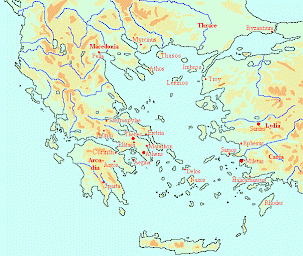
While Aegina and Athens are at each other's throats, the Persian king Darius continues to make plans for the punishment of the Athenians and Eretrians. Mardonius is relieved from his command and replaced by the Median general Datis and Artaphernes, the governor of Lydia (not to be confused with his father Artaphernes, who had held the same position). In their company is Hippias, the tyrant who had been expelled from Athens by Cleomenes, two decades ago (above). He could still count on some support in Athens.
The Persians spend a year building a new navy of no less than six hundred vessels. The new commanders depart from Miletus and avoid the Athos promontory. Their first target is Naxos, the island that Artaphernes' father had once tried to occupy (above). It offers no resistance to the Persian fleet, which soon subdues almost every island in the Aegean Sea. They bring large sacrifices to Apollo when they stay on Delos.
Comment
This sacrifice may seem remarkable, but it is not. The Persians were tolerant towards foreign religions - one might recall how Cyrus the Great allowed to Jews to return home from Babylon - but in this case, there may have been an extra reason. Apollo was the Greek god of wisdom and may have been thought of as the Greek equivalent of the Persian supreme god Ahuramazda, whose name means the Wise Lord.
Herodotus presents the campaign to the west as the Persian revenge for the destruction of the sanctuary at Sardes. This is almost certainly incorrect, but Herodotus loves to see patterns of action and reaction: his normal view on causality. In reality, the aims of the expedition of Datis and the younger Artaphernes were different: to add the islands to the empire, and, in doing so, creating a buffer zone between Ionia and the Greek mainland. The same project had been proposed by Aristagoras when he and the elder Artaphernes attacked Naxos. The Persian aims were, therefore, to conquer Naxos and the other islands, and to occupy Euboea (with its capital Eretria). They also tried to bring back Hippias to Athens.
The battle of Marathon (6.94-140) (cont.)
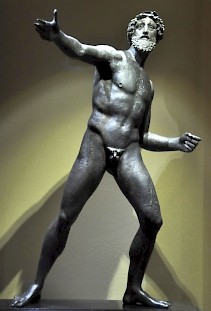
A few days after the sacrifice at Delos, the expeditionary force attacks Eretria. Fighting continues for six days, but the town is betrayed on the seventh day. The Persian army enters the city, strips the temples bare and burns them in revenge for the burnt temple of Cybele (above). The inhabitants are carried off as prisoners.
The part of Athenian territory opposite Eretria -and also the best ground for cavalry to maneuver in- is at Marathon; to this village, therefore, Hippias directs the Persians. The Athenian general Miltiades - the man who had been forced by the Persians to flee from his personal kingdom at the entrance of the Hellespont (above) - hurries to meet the invading army with 10,000 heavily armored infantrymen. At the same time the runner Pheidippides is dispatched to Sparta; three days later, he returns (after covering some 450 kilometer!) with the message that the Spartans will send reinforcements as soon as possible. Unfortunately, a religious law forbids any military operation until full moon, which is six days ahead.
At Marathon, a war of nerves has started. While the Athenians postpone the engagement, they receive reinforcements from their ally Plataea. The problem is that the Persian cavalry is superior; no infantry line can cross the open plain, because its rear will be exposed to attacks by Persian horsemen. Their opponents, on the other hand, are in a hurry, because they know that the Athenians are waiting for Spartan reinforcements.
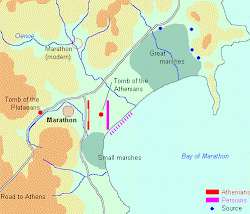
One day, Miltiades receives favorable omens and moves his army in position. He allows the center to be weak but strengthens the wings. At dawn, suddenly, he orders his heavy armored men to run towards their enemies, about two kilometers away. Herodotus remarks that the Persians considered this charge 'suicidal madness'. On the wings the Athenians, fighting with better armor and longer spears than their enemies, rout the invaders; after this first victorious engagement, the wings attack the Persian center from the rear. According to Herodotus, the Athenians loose 192 men in the ensuing mêlée, their opponents 6,400.
However, the rest of the Persian army can retreat safely. The fleet picks up the soldiers and brings them to the harbor of Athens. There, they can see that the Athenian army has marched from Marathon, and is ready to oppose a second invasion. Seeing that it is impossible to take Athens by surprise, Datis and Artaphernes order the fleet to return to Asia. The captive Eretrians are deported to Mesopotamia.
After the victory at Marathon, Miltiades leads an attack on the Cyclades, the archipelago that the Persians had recently added to their empire. It is no success: he is wounded and he dies from gangrene. Herodotus must have thought that this was not a fitting end for the man who had saved Greece from Persian rule: he ends this logos with a story of a more glorious achievement, Miltiades capture of Lemnos, several years before.
Comment
The famous battle of Marathon was probably fought on 12 August 490. The number of Persian casualties is exaggerated (192 × 33 1/3), but no doubt the invaders suffered severely. A German officer, Hauptmann Eschenburg, who visited the site in 1884/1885, mentions how a Greek farmer had discovered huge masses of human bones, which seemed to belong to hundreds of people. Eschenburg made a short dig and was able to corroborate the statement. The fact that there was no monument whatsoever, seems to suggest that this mass burial was done in a hurry. (That the Athenians buried the Persians was a pious act, but the Persians must have been shocked when they heard about it: it was their practice to expose their dead to the vultures.)
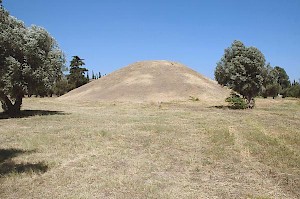
The Athenians and Plataeans received more decent tombs. The tumulus covering the graves of the Athenians is in the middle of the plain and the tomb of the Plataeans can be seen near the small museum at a village called Vrana. It was unusual that Greek warriors were buried on the battle field; the example of this burial must have been the famous poem the Iliad, where we read how the heroes of the Trojan War received burials on the battle field.
The Persian vessels may have transported 25,000 soldiers, but ultimately it was not numerical strength but discipline and armament that lead to Greek victory. One great mystery remains, however: how could the Athenians cross the plain without fear for a cavalry attack? Herodotus suggests that their charge was too swift, but contradicts this when he says that the struggle was long drawn out (which means: more than two hours).
There is, however, another story about this battle, to be found in the biography of Miltiades by the Roman author Cornelius Nepos (first century BCE) and the Suda, a tenth century Byzantine lexicon. They say that one night, Ionian deserters had come to the Athenian camp, telling that the cavalry were away.
The question remains what caused the Persian commanders to send their horsemen away. A possible explanation is that they had become uneasy with the stalemate, had decided to leave the plain to attack the Athenian harbor, and had ordered the cavalry to embark on the transports. If this speculation is correct, the Athenians just attacked the Persian rearguard.
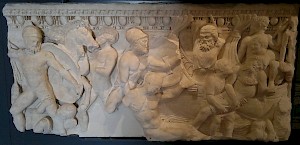
Whatever the truth, it is certain that cavalry took part in the final stages of the battle, because at least one Persian horseman was depicted in a contemporary painting representing the battle (in the Athenian building known as Stoa Poikilê). This painting was already lost in 400 CE, but in the Italian town Brescia, a relief can be seen that is based on it.
The romantic story about the runner who came from Marathon to say that the Athenians had been victorious and died from exhaustion, is untrue. It originates in a combination of two stories: Pheidippides' athletic achievement and the swift Athenian march from Marathon to the harbor. The famous legend is told by Plutarch of Chaeronea.note
Rumor has it that throughout the night, one can still hear horses whinnying and men fighting.